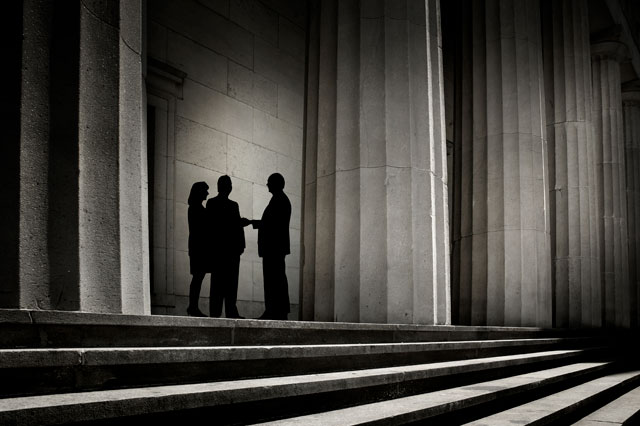
Steven Spielberg’s new movie The Post presents the story behind Katharine Graham’s decision to publish the Pentagon Papers in The Washington Post. As the closing credits roll, one is left with the impression of a publisher who adopts an adversarial stance towards powerful government officials. Despite the director’s $50 million budget (or, perhaps, because of it), there are crucial details that are swept under the rug — details that might lead viewers towards a more accurate understanding of the relationship between the mainstream corporate press and the government.
The public record offers some clarity. Three years after Graham decided to go public with the Pentagon Papers, Seymour Hersh revealed a Central Intelligence Agency (CIA) program called Operation CHAOS in The New York Times. Hersh cited inside sources who described “a massive, illegal domestic intelligence operation during the Nixon Administration against the antiwar movement and other dissident groups in the United States.” Hersh’s article on CIA domestic operations is pertinent because, along with earlier revelations by Christopher Pyle, it prompted the formation of the Church Commission.
The Church Commission was chartered to examine abuses by United States intelligence agencies. In 1976, the commission’s final report (page 455 of Book I, entitled “Foreign and Military Intelligence”) found that the CIA maintained “a network of several hundred foreign individuals around the world who provide intelligence for the CIA and at times attempt to influence opinion through the use of covert propaganda” and that “approximately 50 of the [Agency] assets are individual American journalists or employees of US media organizations.”
These initial findings were further corroborated by Carl Bernstein, who unearthed a web of “more than 400 American journalists who in the past twenty‑five years have secretly carried out assignments for the Central Intelligence Agency.” Note that Bernstein was one of the Washington Post journalists who helped to expose the Watergate scandal. He published his piece on the CIA and the media with Rolling Stone magazine in 1977.
So who exactly were these media collaborators? A declassified memo from 1965 offers a clue. In particular, the memo lists a series of journalists and publishers that periodically spoke with Ray Cline, then deputy director of the Directorate of Intelligence for the CIA. These were individuals who were picked in an effort to allow Cline to serve as a “source of information” in order to “benefit the general rapport of the agency” with the press. Guess whose name is included on this list? Katharine Graham, publisher of The Washington Post and Newsweek.
According to former New York Times journalist James Risen, ongoing stealthy arrangements serve a purpose. Risen indicates that officials are “regularly engaged in quiet negotiations with the press to try to stop the publication of sensitive national security stories.” To do so, they need to offer incentives. Hence, in exchange for being granted veto power, these same officials soft-pedal leak investigations so that insiders can provide juicy bits of classified data to the press on a steady basis. The big-name publishers are able to create the kind of headlines that attract eyeballs, and shadowy government agencies acquire leverage to quash certain stories. Risen was on the receiving end of this dynamic for years. Publishers boost sales, spies frame the narrative to suit their purposes and honest journalists suffer. Insiders win, democracy loses.
But it gets worse. It’s not just certain news outlets that have been compromised. Infiltration and subversion are techniques that have been refined to high art over the decades by the spy masters in Langley. Back in 1967, Ramparts magazine revealed that the CIA had been covertly funding the National Student Association. As Hugh Wilford’s extensive research demonstrates, this was just the tip of the iceberg. The CIA’s “mighty Wurlitzer,” as the agency’s covert propaganda apparatus was referred to internally, covered a broad range of front groups that spanned society.
To think that all of this simply vanished in the late 1960s is a dubious proposition. Consider that when President Reagan signed Executive Order 12333 in 1981, the definition of special activities (i.e. clandestine operations) changed. The original definition of special activities was (emphasis added): “Activities conducted abroad in support of national foreign policy objectives which are planned and executed so that the role of the United States Government is not apparent or acknowledged publicly.”
In 1981 the definition of special activities became: “Activities conducted in support of national foreign policy objectives abroad which are planned and executed so that the role of the United States Government is not apparent or acknowledged publicly.”
In other words, as things stand now, domestic operations are fair game. In light of this, perhaps it shouldn’t be surprising that while the large agenda-setting members of the corporate media portray themselves as defenders of the public interest who relentlessly scrutinize those in power, there are long-standing back channels that remain unseen. Far from being opponents of the political class, media figures are often their close partners.
Join us in defending the truth before it’s too late
The future of independent journalism is uncertain, and the consequences of losing it are too grave to ignore. To ensure Truthout remains safe, strong, and free, we need to raise $47,000 in the next 8 days. Every dollar raised goes directly toward the costs of producing news you can trust.
Please give what you can — because by supporting us with a tax-deductible donation, you’re not just preserving a source of news, you’re helping to safeguard what’s left of our democracy.